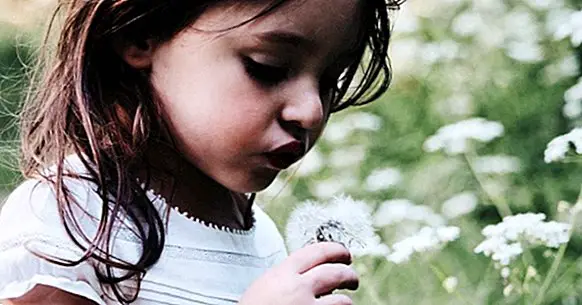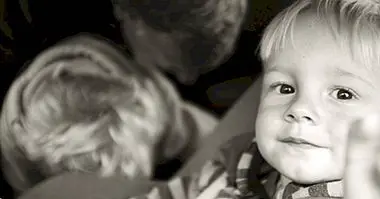Disordered social relationship disorder: symptoms, causes and treatment
It is usual to perceive very social children and that they do not feel any sense of strangeness before other people as something positive. Affable, affectionate and friendly people of which parents are usually proud.
Although these behaviors do not have to be a problem, when they are expressed in an excessive way they can be a reflection or manifestation of the uninhibited social relation disorder , which we will discuss throughout this article.
- Maybe you're interested: "The 6 stages of childhood (physical and psychic development)"
What is uninhibited social relationship disorder?
Traditionally, uninhibited social relationship disorder (TRSD) was considered as part of a wider diagnosis known as reactive disorder of childhood bonding. However, in the last update of the DSM-V it is already established as a specific and independent diagnostic label.
This type of psychological alteration occurs exclusively in childhood and is characterized by presenting a specific pattern of behavior in which the child does not present any kind of fear or discretion in relation to initiating any contact with unknown adults .
These children have a completely uninhibited behavior in which they feel comfortable talking, initiated physical contact or even leaving with a stranger or stranger to him.
This particular behavior pattern appears around the first five years of life , so it can only be diagnosed as such between nine months and five years of age of the child. In addition, these behaviors tend to persist over time regardless of circumstances or changes in the environment around them.
- Related article: "Child attachment: definition, functions and types"
Development throughout childhood
At the moment in which the social relationship disorder is consolidated, the boy or girl shows a tendency to present behaviors of search of attachment, as well as persistent behaviors that reveal a non-selective bonding. That is to say, the minor is capable of maintaining attachment links with any person .
Around the age of four years this type of links are maintained. But nevertheless, Attachment seeking behaviors are replaced by constant demands for attention and for manifestations of indiscriminate affection and affection.
When the last stage of childhood arrives, it is possible that the child has established a series of links with certain specific people, although the behavior of demand for affection tends to be maintained. Uninhibited behaviors are common with schoolmates or peers.
Also, depending on the context or the reactions of the people around you, the child can also develop behavioral changes and emotional changes .
This disorder has been observed more or less commonly in children whose parents or caregivers manifest frequent changes in terms of manifestations of attachment, insufficient care, abuse, traumatic events, poor or insufficient social relationships.
Although they can also appear under other conditions, the highest incidence of this alteration usually occurs in children who have spent the first years of their lives in institutions for childhood .
What symptoms does it present?
The main symptoms of uninhibited social relationship disorder are behavioral in nature and are expressed in the child's way of relating to others, especially adults.
The main symptomatology of this condition includes:
- Absence of feelings of fear or fear towards strangers.
- Active and uninhibited interaction with any unfamiliar or familiar adult.
- Verbal behavior and manifestations of overly familiar physical affection , taking into account social norms and the age of the child.
- Tendency to not need to return or resort to parents or caregivers after remaining in a strange or alien environment.
- Tendency or disposition to leave with a strange adult .
What are the causes?
Although a large number of psychological alterations typical of childhood are usually attributed to some kind of genetic defect, the uninhibited social relationship disorder is a state that is based on a conflicting history of care and social relationships.
However, there are certain theories that point to the possibility that certain biological conditions associated with the minor's temperament and affective regulation.According to these theories, functional alterations in specific brain areas such as the amygdala, the hippocampus, the hypothalamus or the prefrontal cortex, can lead to changes in the child's behavior and ability to understand what is happening around them.
Regardless of whether these theories are true or not, at the moment social negligence and the deficit in the quality of care have been established as the main causes of the development of the uninhibited social relation disorder.
The contexts of family violence, the deficit of basic emotional assistance, education in unfamiliar contexts such as orphanages or constant changes in primary caregivers they are the breeding ground to the impossibility of developing a stable attachment and the consequent development of this disorder.
Diagnostic criteria of the TRSD
Because children with uninhibited social relationship disorder may seem impulsive or with attention problems, the diagnosis can be confused with that of attention deficit hyperactivity disorder.
However, there are a series of diagnostic criteria that allow the correct detection of this syndrome. In the case of the Diagnostic and Statistical Manual of Mental Disorders (DSM-V), the child must present the following diagnostic requirements:
1. Behaviors of approach and active interaction with strange adults
Two or more of the following criteria are also presented:
- Partial or complete absence of distrust to interact with adults other than the child.
- Patterns of verbal or physical behavior excessively familiar according to social or cultural norms.
- Lack of need of the caregiver after exposure to unknown contexts or strangers.
- Partial or complete disposition to leave with a strange adult.
The behaviors of this criterion do not have to be limited to impulsiveness, but they must include socially uninhibited behaviors.
2. The minor has been involved in situations or contexts of deficit care
For example:
- Deficit in the coverage of basic emotional needs.
- Negligence situations .
- Constant changes in the custody or in the main caregivers.
- Education in unusual contexts as institutions with a large number of children per caregiver.
In addition, it must be deduced that the care factor of the second criterion is responsible for the behaviors of the first point.
3. The child's age must be between 9 months and 5 years
This criterion serves to delimit the age range in which it is considered that this mental disorder has its own characteristics.
4. Behaviors must remain for more than 12 months
A criterion to establish the persistence of symptoms.
Is there a treatment?
The treatment of uninhibited social relationship disorder aims to not only modify the behavior of the child, but also that of the parents .
In the case of parents or caregivers, actions must be carried out on certain aspects of the relationship with the child. Work the security transmission, the permanence of the figure of attachment and sensitivity or emotional availability are the three pillars to begin to perceive changes in the child.
In addition, the health professional must also perform a psychological treatment with the child that allows him to rebuild and restore the feeling of safety of this.



















